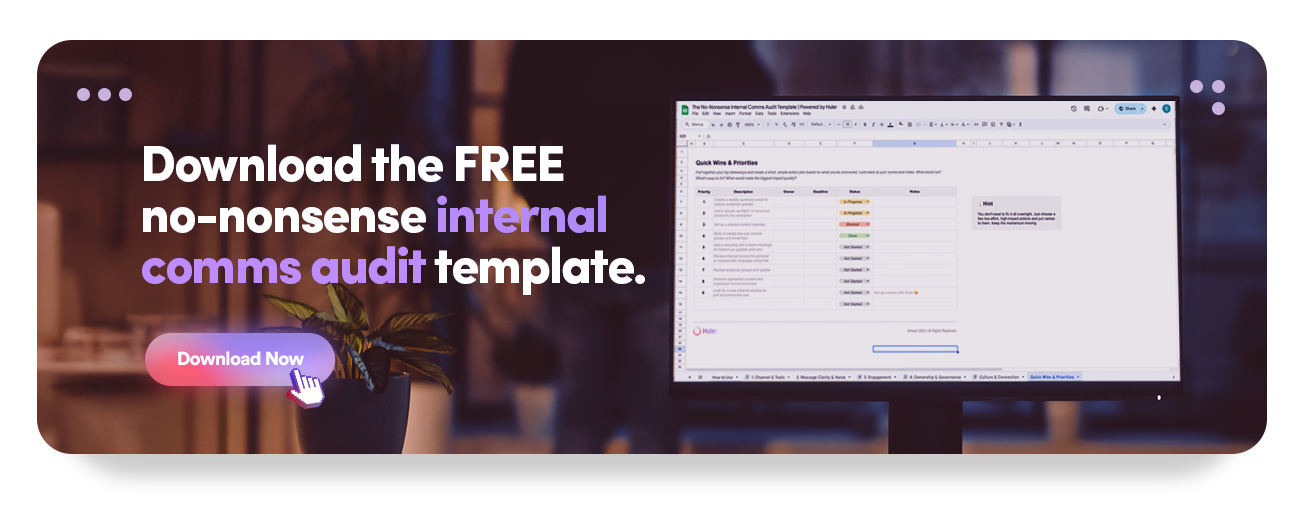Struggling to figure out if your internal comms are hitting the mark, or just adding to the noise in your employee’s inbox? The good news is, you don’t need to embark on a six-month strategy overhaul or bring in a team of expensive consultants to find out. A powerful internal communications audit can be conducted in-house, in under an hour (okay, maybe more like two), with absolutely no budget. You just need to know what to look for and have the right tools to hand.
This guide will walk you through everything you need to know about conducting a swift, effective internal comms audit. We’ll demystify what an audit truly is, highlight what to focus on, and show you exactly how to execute it without draining your time or budget. Plus, we’ll introduce you to our free, no-nonsense template designed to help you get started today.
Why bother auditing your internal comms?
If your emails are going unread, your company updates are being ignored, or you find yourself repeating crucial information across half a dozen different platforms, then your internal communications simply aren’t landing. Ineffective communication often translates to a struggling company culture. You already know this, but if a recent employee survey highlighted that your team feels out of the loop, misses important updates, shows declining engagement, or seems generally confused, it’s a clear signal that it’s time for an audit.
An audit isn’t about pointing fingers, it’s about making your comms work smarter, not harder.
It will help you to:
1) Drown the noise: Identify and eliminate redundant messages and channels that overwhelm your employees
2) Spot what’s being missed: Pinpoint where vital information isn’t reaching your audience.
3) Fix broken connections: Repair or re-evaluate communication channels that are no longer effective or simply aren’t being used.
4) Align comms with people’s needs: Ensure your messages are designed to genuinely benefit your employees, rather than just fulfilling a checkbox exercise.
What to include in your internal comms audit
Don’t overcomplicate this. An effective audit doesn’t require consultants, hefty budgets, or lengthy timelines. Sometimes, the most powerful insights come from taking it back to basics and applying a critical, honest eye.
Here’s what to examine when reviewing your internal comms:
Channels and tools
Start by listing every single platform you currently use for internal comms. Think broadly: email, slack channels, MS teams, internal newsletters, digital signage, even physical noticeboards. For each, ask yourself:
1) Which of these tools are truly being used most effectively by your team?
2) Are there any that are consistently ignored or underutilised?
3) Is the messaging consistent across all your chosen platforms, or are people getting conflicting information?
Tip: When it comes to channels, less if often more. If you’re duplicating information across four different places, chances are nobody knows where to look for the definitive version. This duplication can lead to confusion and message fatigue.
Message Clarity
Next, assess the content of your communications. Are your updates genuinely clear, relevant, and easy for employees to understand and act upon? Consider:
- Is the tone of your messages human, approachable, and to the point, or does it sound like corporate jargon?
- Are you tailoring communications for different teams, departments, or roles when necessary?
- Beyond just sending, are people actually reading and comprehending what you’re trying to convey?
Remember, you’re not writing a press release for external stakeholders. If your internal messages sound stiff, overly formal, or full of buzzwords, it’s probably time for a rewrite.
Frequency and timing
There’s a delicate balance to strike with communication frequency. Too much can lead to burnout and employees tuning out; too little can leave them feeling uninformed and disconnected. Reflect on:
- Are you communicating too frequently, overwhelming inboxes, or not often enough, leaving gaps in information?
- Do your employees know when to expect important updates, or are messages landing sporadically?
- Are crucial messages getting buried in a deluge of less important information?
Practical advice: Where possible, track engagement metrics. Look at email open rates, click-through rates on intranet articles, or even comments and reactions on team collaboration platforms. Any data that shows whether your messages are landing and resonating is valuable.
Leadership visibility
The presence and communication style of your leadership team are paramount. Are your leaders actively communicating with the team, or do they seem to be “ghosting” employees? Consider:
- Are leadership updates regular, authentic, and transparent?
- Are these communications two-way, inviting questions and feedback, rather than just top-down directives?
- Do employees trust what’s being shared by leadership?
Silence from leadership can quickly breed confusion and a lack of trust. Consistent, visible leadership builds confidence and fosters a stronger, more cohesive culture.
Employee feedback and engagement
Finally, if you’re not actively asking your employees what they think about your internal communications, you’re essentially operating on guesswork. An effective audit needs an employee perspective. Ask yourself:
- Have you directly solicited feedback on your internal communications efforts?
- Do employees know how to share their ideas, ask questions, or raise concerns about communication?
- Are you “closing the loop” by acknowledging feedback and communicating what actions are being taken as a result?
Even a single, quick pulse survey focused specifically on internal communications can provide invaluable insights into what’s working well and what desperately needs improvement.
How to run a low-cost, fuss-free internal comms audit
The beauty of an internal comms audit is that it doesn’t require a huge investment of time or money. Here’s a simple, actionable plan to get it done efficiently:
- Grab the Right Template: Why reinvent the wheel? We’ve created a straightforward, practical internal comms audit template specifically designed for busy teams. It’s completely free, cuts through the waffle, and is built for immediate use. [Download your free, no-nonsense template here!]
- Block Out 30-60 Minutes: Schedule a dedicated time slot. You can gather your HR, Internal Comms, or Marketing team, or simply grab a coffee and conduct the audit solo. The primary goal is to get an honest, objective snapshot of your current communication landscape.
- Work Through Each Section: Use the provided template as your guide. Systematically review your channels, message clarity, communication frequency, leadership visibility, and employee engagement. Be honest with your assessments – this isn’t the time for ego, but for genuine improvement.
- Highlight Quick Wins: You don’t need to fix every single issue in one go. Focus on identifying what’s most confusing, heavily duplicated, or consistently ignored. Prioritize these areas for immediate action. These “quick wins” can build momentum and demonstrate early success.
- Share Findings and Take Action: Even a lightweight audit can spark significant positive changes. Share your findings with your relevant team members and collectively decide what needs to be tweaked, discontinued, or amplified. Make a plan and commit to the necessary adjustments.
Ready to get started?
Your internal communications should empower your people, not frustrate them. Taking the time to conduct a simple audit is your crucial first step toward cutting the chaos and ensuring your messages resonate.
We’ve built a plug-and-play internal comms audit template specifically to help you kickstart this process. It’s completely free to download, with no strings attached.





